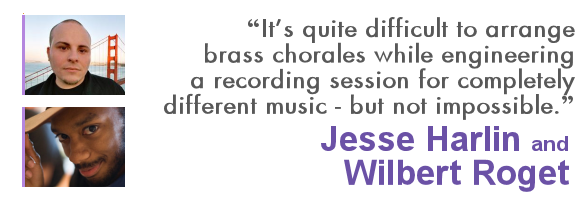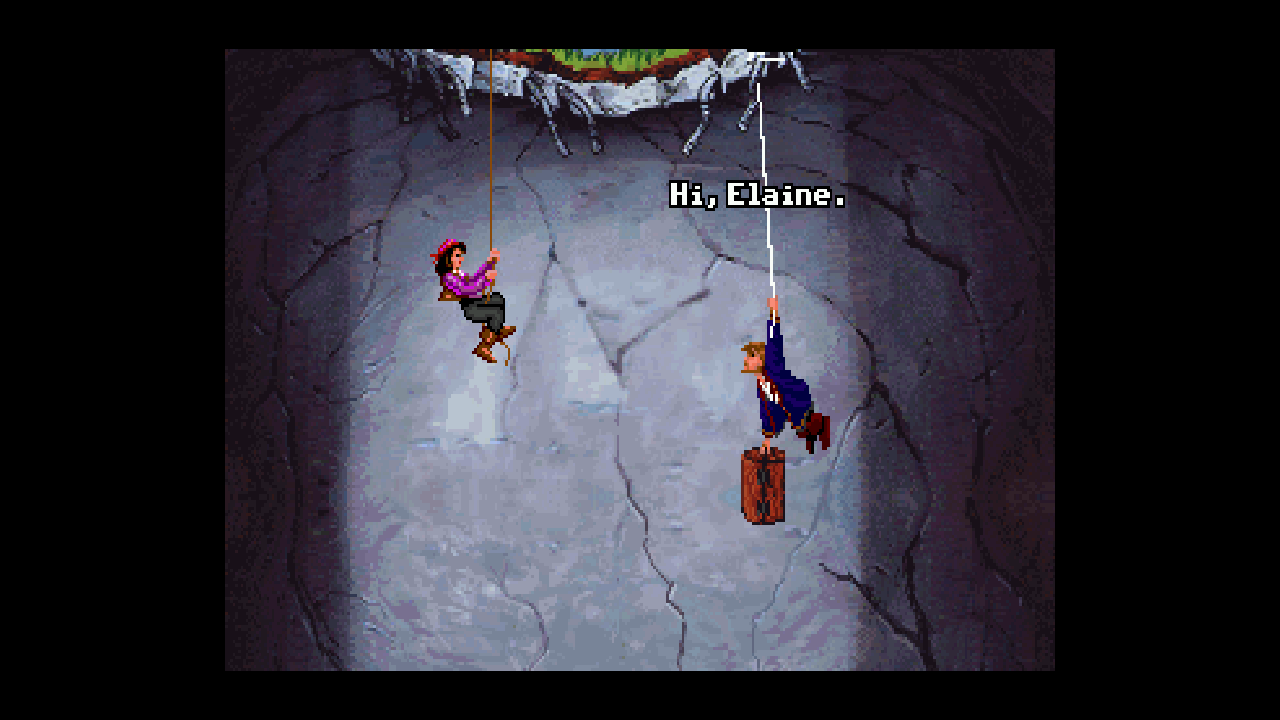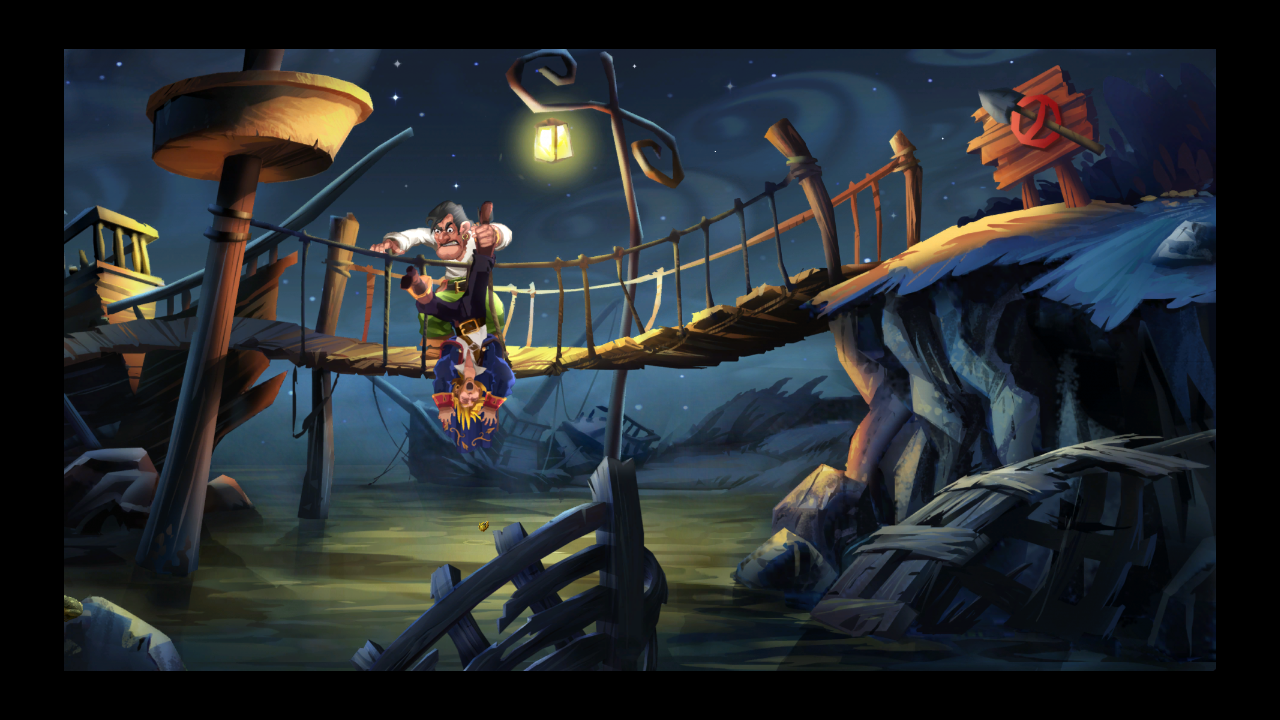Articles

Jesse Harlin and Wilbert Roget Interview iMUSE, Gold Guy arrangement, and anecdotes...
One of the ground-breaking features of MI2 was the use of the iMUSE system, developed by Michael Land and Peter McConnell, which allowed the game to have an interactive soundtrack that responded to the player‘s actions and allowed for seamless transitions between different cues. What were the challenges in bringing this system to a purely digital soundtrack, as opposed to MIDI? Did you have to make any compromises?

Holy crap... Woodtick... Perhaps the most complicated piece of interactive music in the history of video games. Michael and Peter are geniuses, but I think it’s telling that even they never tried anything again as complex as the interactive music system they devised for Woodtick. But let me back up a bit …
You’re correct. iMUSE was created for Monkey 2 to give it a rich and reactive music system. Much of it is still room-based, as Monkey 1 was, but by using extremely sophisticated MIDI data, they were able to do seamless transitions from one piece to the next. Because MIDI is just numbers that tell your sound card which notes to play and when to turn them off, these smooth transitions are easier to do than with digital audio. With digital audio, you’re working with actual recordings of trumpets and clarinets and whatnot. You can’t just send out a message that says “Hey, recording of a trumpet: in two bars change which notes you’re playing.” It doesn’t work that way. You have to change to an entirely different piece of audio. Changing between digital audio chunks can create sync issues, pops, clicks, you name it. It’s tricky.

Reproducing iMUSE’s functionality with digital audio was an incredibly daunting task, especially since Monkey 2 made more comprehensive use of this technology than any other game after it. I went through several prototypes before arriving at the solution we can hear in the game. iMUSE can do things like turning on and off instruments, play transitional cues between two tracks based on the measure at which you ended the previous track, play overlaid solo instruments for a single measure over the current track based on the current measure… the list goes on. We were able to make unique audio files for every contingency, and designed an interpreter between the game and the audio engine to “translate” the iMUSE requests and imbue musical information (tempo, number of measures, and so on) into all of the audio files. Digital audio is nowhere near as malleable as MIDI, but since we knew every way the MIDI files on Monkey 2 were being affected, we were able to “cheat” the system by covering every possible contingency.

And because iMUSE is a deeply ingrained part of Monkey 2, its code is still tied into Monkey 2: SE, it just isn’t actually doing anything. It’s there, and it’s trying to call MIDI files; but the MIDI files aren’t there and there’s now a new system of code that supersedes it that makes all of the calls for the digital audio cues. The reason for this is that we thought the original iMUSE calls would help out. Unfortunately, they got in the way and we found ourselves going case by ever-increasing case and turning them off. Eventually we just bypassed them all, but they’re still there. Sometimes this created a bit of a house-of-cards scenario and introduced some bugs that drove Wilbert nuts. For instance, there is no reason any of us can figure out for why the flute overlays aren’t playing back correctly when you go from outside the Voodoo Lady’s hut into the interior scene. The cues are there and for about a week they played correctly. Then they didn’t. And we could never get it to work right again.
Now, all of that said, what is absolutely amazing is that the functionality of what’s there works exactly the same on the Xbox, PS3, and PC as it does on the iPad and iPhone. What Wilbert and our engineers achieved is – without a doubt – the most complex digital audio system ever used on the iOS platform. To have something like up to 8 simultaneous streams of audio playing on the iPhone is nothing short of astounding.
MI2 is a considerably larger game than its predecessor, which has an impact on not only the amount of music in the game, but also the "epicness" of several cues. Did that influence your approach to adapting the soundtrack? What was different compared to the SE of MI1?

Stylistically, Monkey 2 does have a slightly different feel from Monkey 1. The aesthetic for our Monkey 1 arrangements was to emulate smaller bands, jazz club bands, bands playing in a loud noisy pub, and so on. Monkey 2 required larger ensembles such as New Orleans big bands and even full-orchestral numbers, so we had to revise our strategy for live instrumentalists. We hired clarinet, sax, trumpet, and trombone soloists to play on many of the tracks. I played woodwinds and keyboards myself, and one of our arrangers (Jeff Ball) is also a phenomenally talented violinist. On a few of the orchestral tracks, he plays alongside the sampled strings to get a more intimate, live-recorded feel.

Our arrangers often did fairly straight forward updates of the tracks originally, as well. We’d usually get a first pass and I’d listen and say things like “this doesn’t push it far enough.” I’d have them add things like the harpsichord continuo part to Wally’s Woodtick variation so that it went fully baroque, or make them redo the percussion on the Cemetery track so that it sounded like it was coming out of an old Yamaha funeral parlor organ, or I’d send them YouTube videos of antique orchestrion recordings for the finale Carnival tracks. Will thought I was crazy because we’d review their tracks in his office and I’d always run off yelling that I was going to find YouTube links to illustrate the obscure sound I was looking for with that track. The biggest stylistic departure is probably the “Captain Dread” tracks. When I heard them for the first time, I thought they felt flat. They were clearly reggae but didn’t feel like they had any life to them. I really wanted to put some swing into them and give them some bravado, and I had this vision of what I wanted them to sound like. So, rather than try to explain what I heard in my head, I took those and just did them myself.

When re-recording the soundtrack to the first game you had to make a few alterations to the arrangements and added a few of your own ideas to some of the cues. Furthermore you were able to write a short new cue for the Gold Guy logo. How was it this time around?

We mostly stayed true to the original pieces in both games, but there were times where some of the instrumentation had to be reworked to suit the live players we had available. We also tend to rewrite the drum parts, since MIDI drum sounds were rather limited in the kinds of sounds they could produce back then. And, again because the scores were written for synthesizers and not live players, many instruments were written well outside of their playing range. So we had to find ways to make that work with live instrumentalists.

One of the biggest changes we made in terms of changing the notes on the page is with the “Mardi Gras” track for Elaine’s mansion. When you hear the original, it’s clear that it’s a Dixieland jazz piece and Dixieland jazz is so deeply comprised of virtuosic improvisation that I knew we needed to get that energy into the updated version. So, rather than having the players reproduce what’s exactly in the original track, we have the bass instruments and the trumpet playing the original cue. The other instruments, however, were given chord charts and asked to improvise. We’d do about three passes through the tune and they we’d edit together the best pieces into the final tracks. In the end, it has exactly the sense of playful freedom that I was looking for in the updated track.

About the Gold Guy, it was my first opportunity to write one of those classic LucasArts jingles and I had a blast working on it! I only had a few hours in one night to work on it as the logo was finished very late in the project, but luckily our violinist Jeff Ball keeps the same nocturnal hours I do, and so I was able to incorporate his violin playing into the score. I used old Looney Tunes cartoons as well as classic black-and-white Disney cartoons as inspiration, but then filtered the arrangement through the Monkey Island musical style.

When I first started working at LucasArts, Mark Griskey was the other on-staff composer and he told me that the key to any good Gold Guy is the Lydian scale. He’s totally right; it always works.
The game features a cool little musical number, complete with music and lyrics. Of course, the MIDI-nature of the original game had the lyrics only written in text. How did you tackle this?

This was a very tricky area of the game that we were concerned about throughout the entire production phase of the project. The “Dem Bones” song is actually randomized in text - every time one plays through the game they one of eight different nonsensical rendition of the tune. One time you might hear “The rib bone’s connected to the leg bone!”, and the next time it might be “The head bone’s connected to the hip bone!”

I think this was a classic case of us over-thinking a problem. You see, when you make a game, you compartmentalize the audio into three categories: sound effects, voice, music. So, we set off on updating each of those individually and eventually all implement our changes and then see how it all plays with each other. The sync on the “Dem Bones” song was so tough to nail down because we first treated it like two separate elements: voice and music. This was because there are specific rules that console manufacturers have when you make a game that developers have to follow. On the Xbox, you have to be able to replace the music at any time you want with music on your hard drive. We couldn’t mix the voice and music together because the voice would suddenly disappear if you got to that scene while listening to your own soundtrack. The tech was such that we couldn’t play overlapping lines of dialogue, so we couldn’t have a 8 single long files that randomized because Guybrush talks in-between the singing and the onscreen subtitles are tied to individual voice lines triggering.

We iterated on this problem for days and days, retiming the music, re-recording and re-editing the voices in various ways, before arriving at our final “best compromise” method which favored natural flow of the voices over synchronization with the music.

No one was happy with it, though, and when we put out a patch for the game to fix some other issues, we tackled that. In the end, we tried to make it work by trying a solution with 8 randomized long voice files. It turns out we were actually saved by a bug. While we had those long files playing, plus Guybrushes dialogue playing overtop of them, somehow the system let that happen even though it shouldn’t have. Not ones to look a gift bug in the mouth, we ran with it. So, the final solution to the problem is something that shouldn’t really work at all the way the voice system was designed. But it does.
The resource files of the demo version of the game contained a few pieces of music, not found in the final game. Were there any other unused bits discovered during production?

There wasn’t too much of that with Monkey 2. We didn’t actually go through and recreate the score 100% cue for cue with the original. If you look at the MIDI files from the original game, there are dozens of little variations on some of these tiny, maybe 2 second long trumpet stingers that happen every time Guybrush gets stabbed by the voodoo doll in the tunnels of Dinky Island. We didn’t need to redo all of them. I think we did about 10, all told. There were also some tracks that were originally separated out as two or more MIDI files that we combined into a single audio file. These were always cases where something was a scripted cutscene that would play piece after piece after piece in a row, without ever changing order or timing, and it just made sense to effectively glue them all together into a single file instead of worrying about having to transition between them with software.

Judging by our last interview, I bet you have a few interesting anecdotes from the production of the MI2:SE...

For one thing, I never thought I’d need to use my French harpsichord chops ever again after 8th grade... but then Phatt Mansion happened!
One of my favorite moments was during the brass recording sessions. Our trombonist was playing the melody from the Cemetery theme, and upon hearing it live, Jesse and I both agreed it’s “a shame this is just a solo – it’d sound so cool as a three-part brass chorale!” Well I happened to have some blank musical-staff paper nearby and, long story short, it’s quite difficult to arrange brass chorales while engineering a recording session for completely different music – but not impossible.

I loved our instrumentalist sessions on this game. On Monkey 1, we had a really great brass section come in and record a bunch of tracks together for us. With Monkey 2, though, the game didn’t really need a brass section so much as this ever-changing combination of clarinet, trombone, trumpet, and sax. So, we brought the players in each on their own and then overdubbed all of the parts one at a time. The great thing about this is that we had the luxury of really getting these great organic sounds out of the instruments. They’d all bring their own literal bag of tricks, whether that was a bag full of different kinds of mutes for the trombone or a collection of different kinds of reeds for the clarinet. Our clarinet player, a guy named Sheldon Brown, had this one reed that he said was great for sliding around on different pitches, but if you wanted a really clean and focused sound it wasn’t so useful. This became known as the ”sleazy reed” and it was used all over the score for things like those great scoops in the clarinet line when Guybrush is in jail on Phatt Island. Our trombone player, Marty Wehner, also had a special mute for his trombone called a bucket mute. It looks like its namesake. It’s this big metal bucket-looking thing that sits over the end of the trombone, and even among trombone players is apparently a fairly rare mute. But it has this beautiful somber sound. Any time we needed to do trombone work for cues like the Scabb Island cemetery or LeChuck’s fortress, the bucket mute would come out and give us this great funereal tone.
Perhaps my favorite, though, was when Will told me how the melodic iMUSE overlays worked in the original confrontation scene between Guybrush and Elaine in her bedroom on Booty Island. When we first played through it, I didn’t realize that the cues were actually split into two different banks of Negative and Positive responses. If you’re a jerk to Elaine, you get a negative response. If you’re suave, you get a positive response. It’s really very clever work on the part of Michael, Peter, and Clint. So, as with everything else, I really wanted to amp these up and make them completely obvious while still being fun. So, the positive cues were easy to do via a simple chord chart and a sense of what sounds “nice.” The negative cues, however, were awesome. We basically just kept asking the instrumentalists to make the ugliest noises they could come up with out of their instruments. When you’ve spent 30 years refining your craft at your instrument to make it sound as good as possible, it can be hard to throw all of that away and make intentionally ugly sounds. They did a great job, though, and I was in stitches in the recording booth while they make these ridiculous noises.
A lot of people (including me) are still hoping for official soundtrack releases to the Monkey Island games and other LucasArts titles, like Lucidity. Anything on the horizon?

Unfortunately we can’t talk about our future plans regarding soundtrack releases, but it is something we have been working on for a long time.
Thank you very much for another great interview!

You’re welcome!

And thank you! I’m extremely grateful to be a part of the Monkey Island franchise, and honored to have had an opportunity to work with iMUSE. When I first started out as a professional game composer, I researched the iMUSE system and its various abilities. At my first visit to the Game Developers Conference, I had the opportunity to meet Peter McConnell and Michael Land in person, and hear war stories about composing and programming the Woodtick themes. I never would’ve guessed that five years later I would be a part of it as well!